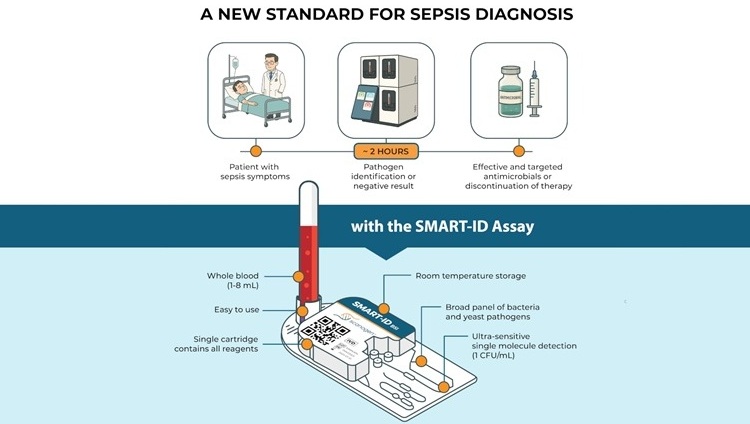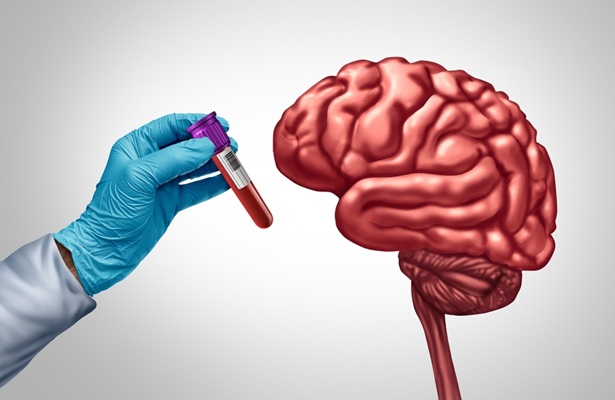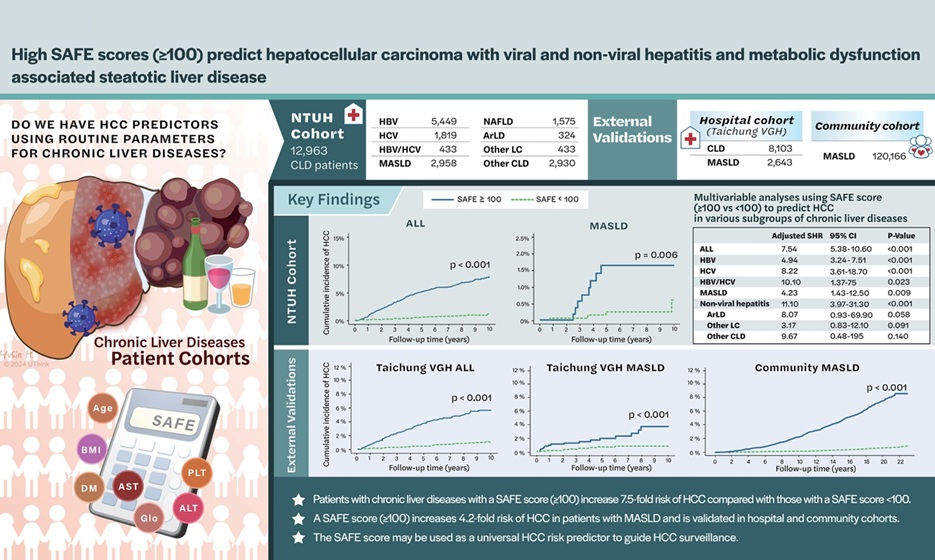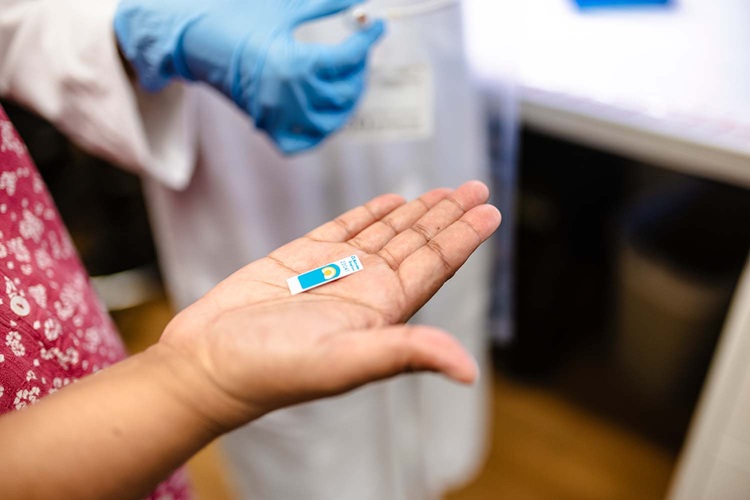A Novel Capsule-Based Smell Test for Diagnosis of Neurological and Respiratory Diseases
|
By LabMedica International staff writers Posted on 10 May 2021 |

Image: Photograph of the novel capsule-based smell test (Photo courtesy of Queen Mary University of London)
To aid in diagnosing diseases where loss of the sense of smell is a symptom, such as in chronic neurological conditions like Parkinson's and Alzheimer's diseases and in acute respiratory infections such as that caused by COVID-19, a team of researchers at Queen Mary University of London (United Kingdom) developed a novel smell testing kit based on capsules of aromatic oils placed between two strips of single-sided tape.
This smelling test was made up of aromatic oil capsules that were prepared by a fabrication technique, which enabled full control over the capsule size, the shell thickness, and the volume of the encapsulated oil. The technique generated capsules by concentrically dripping oil/alginate droplets from a coaxial nozzle into an oppositely charged ionic liquid. After formation, liquid capsules were left to dry and form a solid crust surrounding the oil.
The prototype test used in the current study consisted of placing a standardized number of capsules between adhesive strips that users crushed and pulled apart to release the smell. In addition, a simple mathematical model was developed to predict the volume of encapsulated oil within the capsule in terms of the flow rate ratio and the nozzle size.
In this preliminary study, a small group of eight patients with Parkinson's disease were instructed to crush the capsules between their fingers and then peel back the tape strip to release the aroma contained within the capsules.
The participants reported that the smells from the tests were detectable and remarked on the relative ease of rupturing the capsules, particularly for those with tremors, compared to the standard scratch and sniff smell test available on the market.
First author Dr. Ahmed Ismail, a lecturer of fluid dynamics at Queen Mary University of London, said, "Most of the smell tests on the market depend on using paperboard items treated with a fragrant coating called scratch and sniff, in which you need to scratch a card to release the odor. The problem with this approach is that the amount of odor released depends on the extent to which the individual scratches, something that might affect the outcome of the test. Our capsule-based smell test does not have this problem because the amount of odor released is controlled by the amount of oil precisely encapsulated. The mass-production of our new test would also be cheaper than a scratch and sniff test.
Dr. Ismail said, "Our capsule-based smell test can assist in the rapid diagnostic of various diseases linked to the loss of smell. These include chronic neurological conditions such as Parkinson's and Alzheimer's disease, as well as COVID-19, which is known to affect the sense of smell. Being non-invasive and less stressful, the capsule-based smell test has benefits over the nose swab in diagnosing COVID-19. This is an advantage for testing children in particular, as they are typically horrified if they need to do a nose swab, and the test can be done in the comfort of their own home."
The capsule-based smell test was described in the April 28, 2021, online edition of the journal Royal Society Interface.
Related Links:
Queen Mary University of London
This smelling test was made up of aromatic oil capsules that were prepared by a fabrication technique, which enabled full control over the capsule size, the shell thickness, and the volume of the encapsulated oil. The technique generated capsules by concentrically dripping oil/alginate droplets from a coaxial nozzle into an oppositely charged ionic liquid. After formation, liquid capsules were left to dry and form a solid crust surrounding the oil.
The prototype test used in the current study consisted of placing a standardized number of capsules between adhesive strips that users crushed and pulled apart to release the smell. In addition, a simple mathematical model was developed to predict the volume of encapsulated oil within the capsule in terms of the flow rate ratio and the nozzle size.
In this preliminary study, a small group of eight patients with Parkinson's disease were instructed to crush the capsules between their fingers and then peel back the tape strip to release the aroma contained within the capsules.
The participants reported that the smells from the tests were detectable and remarked on the relative ease of rupturing the capsules, particularly for those with tremors, compared to the standard scratch and sniff smell test available on the market.
First author Dr. Ahmed Ismail, a lecturer of fluid dynamics at Queen Mary University of London, said, "Most of the smell tests on the market depend on using paperboard items treated with a fragrant coating called scratch and sniff, in which you need to scratch a card to release the odor. The problem with this approach is that the amount of odor released depends on the extent to which the individual scratches, something that might affect the outcome of the test. Our capsule-based smell test does not have this problem because the amount of odor released is controlled by the amount of oil precisely encapsulated. The mass-production of our new test would also be cheaper than a scratch and sniff test.
Dr. Ismail said, "Our capsule-based smell test can assist in the rapid diagnostic of various diseases linked to the loss of smell. These include chronic neurological conditions such as Parkinson's and Alzheimer's disease, as well as COVID-19, which is known to affect the sense of smell. Being non-invasive and less stressful, the capsule-based smell test has benefits over the nose swab in diagnosing COVID-19. This is an advantage for testing children in particular, as they are typically horrified if they need to do a nose swab, and the test can be done in the comfort of their own home."
The capsule-based smell test was described in the April 28, 2021, online edition of the journal Royal Society Interface.
Related Links:
Queen Mary University of London
Latest COVID-19 News
- New Immunosensor Paves Way to Rapid POC Testing for COVID-19 and Emerging Infectious Diseases
- Long COVID Etiologies Found in Acute Infection Blood Samples
- Novel Device Detects COVID-19 Antibodies in Five Minutes
- CRISPR-Powered COVID-19 Test Detects SARS-CoV-2 in 30 Minutes Using Gene Scissors
- Gut Microbiome Dysbiosis Linked to COVID-19
- Novel SARS CoV-2 Rapid Antigen Test Validated for Diagnostic Accuracy
- New COVID + Flu + R.S.V. Test to Help Prepare for `Tripledemic`
- AI Takes Guesswork Out Of Lateral Flow Testing
- Fastest Ever SARS-CoV-2 Antigen Test Designed for Non-Invasive COVID-19 Testing in Any Setting
- Rapid Antigen Tests Detect Omicron, Delta SARS-CoV-2 Variants
- Health Care Professionals Showed Increased Interest in POC Technologies During Pandemic, Finds Study
- Set Up Reserve Lab Capacity Now for Faster Response to Next Pandemic, Say Researchers
- Blood Test Performed During Initial Infection Predicts Long COVID Risk
- Low-Cost COVID-19 Testing Platform Combines Sensitivity of PCR and Speed of Antigen Tests
- Finger-Prick Blood Test Identifies Immunity to COVID-19
- Quick Test Kit Determines Immunity Against COVID-19 and Its Variants
Channels
Clinical Chemistry
view channel
POC Breath Diagnostic System to Detect Pneumonia-Causing Pathogens
Pseudomonas aeruginosa is a major cause of hospital-acquired and ventilator-associated pneumonia, particularly in lung transplant recipients and patients with structural lung disease. Its ability to form... Read more
Online Tool Detects Drug Exposure Directly from Patient Samples
Doctors often rely on patient interviews and medical records to determine what medications a person has taken, but this information is frequently incomplete. People may forget drugs they used, take over-the-counter... Read moreHematology
view channel
MRD Tests Could Predict Survival in Leukemia Patients
Acute myeloid leukemia is an aggressive blood cancer that disrupts normal blood cell production and often relapses even after intensive treatment. Clinicians currently lack early, reliable markers to predict... Read more
Platelet Activity Blood Test in Middle Age Could Identify Early Alzheimer’s Risk
Early detection of Alzheimer’s disease remains one of the biggest unmet needs in neurology, particularly because the biological changes underlying the disorder begin decades before memory symptoms appear.... Read more
Microvesicles Measurement Could Detect Vascular Injury in Sickle Cell Disease Patients
Assessing disease severity in sickle cell disease (SCD) remains challenging, especially when trying to predict hemolysis, vascular injury, and risk of complications such as vaso-occlusive crises.... Read more
ADLM’s New Coagulation Testing Guidance to Improve Care for Patients on Blood Thinners
Direct oral anticoagulants (DOACs) are one of the most common types of blood thinners. Patients take them to prevent a host of complications that could arise from blood clotting, including stroke, deep... Read moreImmunology
view channelBlood Test Could Detect Adverse Immunotherapy Effects
Immune checkpoint inhibitors have transformed cancer treatment, but they can also trigger serious immune-related adverse events that damage healthy organs and may become life-threatening if not detected early.... Read more
Routine Blood Test Can Predict Who Benefits Most from CAR T-Cell Therapy
CAR T-cell therapy has transformed treatment for patients with relapsed or treatment-resistant non-Hodgkin lymphoma, but many patients eventually relapse despite an initial response. Clinicians currently... Read moreMicrobiology
view channel
Blood-Based Diagnostic Method Could Identify Pediatric LRTIs
Lower-respiratory tract infections (LRTIs) are a leading cause of illness and death worldwide, and pneumonia is the leading infectious cause of death in children under five, claiming the lives of over... Read more
Rapid Diagnostic Test Matches Gold Standard for Sepsis Detection
Sepsis kills 11 million people worldwide every year and generates massive healthcare costs. In the USA and Europe alone, sepsis accounts for USD 100 billion in annual hospitalization expenses.... Read moreRapid POC Tuberculosis Test Provides Results Within 15 Minutes
Tuberculosis remains one of the world’s deadliest infectious diseases, and reducing new cases depends on identifying individuals with latent infection before it progresses. Current diagnostic tools often... Read more
Rapid Assay Identifies Bloodstream Infection Pathogens Directly from Patient Samples
Bloodstream infections in sepsis progress quickly and demand rapid, precise diagnosis. Current blood-culture methods often take one to five days to identify the pathogen, leaving clinicians to treat blindly... Read morePathology
view channel
Rapid Low-Cost Tests Can Prevent Child Deaths from Contaminated Medicinal Syrups
Medicinal syrups contaminated with toxic chemicals have caused the deaths of hundreds of children worldwide, exposing a critical gap in how these products are tested before reaching patients.... Read more
Tumor Signals in Saliva and Blood Enable Non-Invasive Monitoring of Head and Neck Cancer
Head and neck cancers are among the most aggressive malignancies worldwide, with nearly 900,000 new cases diagnosed each year. Monitoring these cancers for recurrence or relapse typically relies on tissue... Read more
Common Health Issues Can Influence New Blood Tests for Alzheimer’s Disease
Blood-based tests for Alzheimer’s disease are transforming diagnosis by offering a simpler alternative to spinal taps and brain imaging. However, many people evaluated at memory clinics also live with... Read more
Blood Test Formula Identifies Chronic Liver Disease Patients with Higher Cancer Risk
Chronic liver disease affects millions worldwide and can progress silently to hepatocellular carcinoma (HCC), one of the deadliest cancers globally. While surveillance guidelines exist for patients with... Read moreTechnology
view channel
Machine Learning Models Diagnose ALS Earlier Through Blood Biomarkers
Amyotrophic lateral sclerosis (ALS) is a rapidly progressive neurodegenerative disease that is notoriously difficult to diagnose in its early stages. Early symptoms often overlap with other neurological... Read more
Artificial Intelligence Model Could Accelerate Rare Disease Diagnosis
Identifying which genetic variants actually cause disease remains one of the biggest challenges in genomic medicine. Each person carries tens of thousands of DNA changes, yet only a few meaningfully alter... Read moreIndustry
view channel
BD and Penn Institute Collaborate to Advance Immunotherapy through Flow Cytometry
BD (Becton, Dickinson and Company, Franklin Lakes, NJ, USA) has entered into a strategic collaboration with the Institute for Immunology and Immune Health (I3H, Philadelphia, PA, USA) at the University... Read more




















